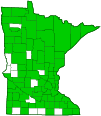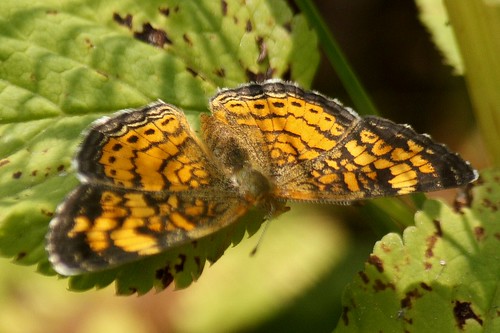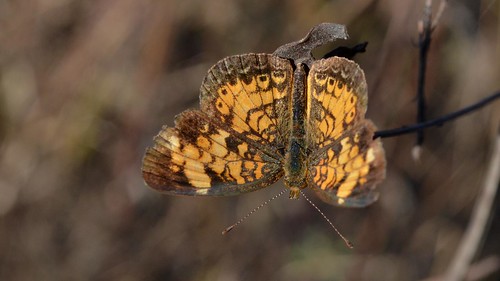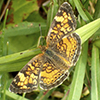pearl crescent
(Phyciodes tharos)
Conservation • Description • Habitat • Ecology • Distribution • Taxonomy
Conservation Status |
|
|||||||
| IUCN Red List | not listed |
|||||||
| NatureServe | N5 - Secure S5 - Secure |
|||||||
| Minnesota | not listed |
|||||||
Description |
||
Pearl crescent is a medium sized brushfoot butterfly. It has a wingspan of 1″ to 1½″. The upperside of the both wings is orange with a broad black border and a black-and-white fringe. There is a small to large patch in the basal area that is is mostly black with many fine, pale specks. The female is larger, darker, and more extensively marked than the male. The upperside of the forewing has four irregular black patches: a subapical patch that merges with the black border; a submarginal patch near the inner margin that merges with the black border; a median patch on the leading (costal) margin; and a median patch on the inner margin. On most individuals, a black jagged line separates the median area from the postmedial area and widens into an irregular black patch near the costal margin. On the female, the median area is yellowish-orange. There are jagged lines in the discal area that form one or two outer and a row of inner orange spots with black borders. The upperside of the hindwing has a submarginal row if pale, crescent-shaped spots within the black border. There is a jagged, uninterrupted, postmedial line and a postmedial row of small black spots. Jagged lines in the discal area create three rows of irregular orange spots with black borders. The underside of the forewing is orange with pale orange costal and apical areas; thin, jagged, dark orange lines; and two ill-defined black patches near the costal margin. The underside of the hindwing is pale orange with thin, jagged, dark orange lines, and an ill-defined, dark orange patch near the costal margin. There is also a dark brown patch near the trailing edge with a pearly white spot. On females, the pale areas are orangish-yellow and the lines are more highly contrasted. The antennae are black and white striped. The antenna club is black on males, black and white striped on females. The tip of the club is orange. The legs are orangish-yellow. The caterpillar is up to ¾″ long and dark brown with numerous tiny white spots. The spots are the expanded base of the hairs (seta). On the thorax and each abdominal segment there is a short, branched spine (scolus) in the middorsal, subdorsal, supraspiracular, spiracular, and subspiracular regions. The base of the scolus is rounded, wart-like, reddish-orange, and shiny. There is a broken white line in the subdorsal and subspiracular areas that extends onto the head. |
||
Size |
||
Wingspan: 1″ to 1½″ |
||
Similar Species |
||
| Northern crescent (Phyciodes cocyta) has a larger speckled black area on the wing uppersides near the body. The hindwing postmedial line is interrupted. There is no pearly white spot in the brown patch in the underside of the hindwing. The flight season begins in June. | ||
Habitat |
||
Meadows, prairies, fields, pastures, forest edges, streamsides, roadsides, and other open areas. |
||
Ecology |
||
Season |
||
Two broods: mid-May to June, and July to early September |
||
Behavior |
||
Young caterpillars feed in groups but do not create nests. |
||
Life Cycle |
||
The male patrols near host plants in search of a receptive female. After mating, the female lays green eggs on the underside of aster leaves in a raft of usually about 36 but as few as 20 to as many as 200. The second brood overwinters as a third-stage caterpillar. |
||
Larva Hosts |
||
White panicle aster (Symphyotrichum lanceolatum), smooth blue aster (Symphyotrichum laeve), and other asters (Symphyotrichum spp.). |
||
Adult Food |
||
Flower nectar of spreading dogbane (Apocynum androsaemifolium), white clover (Trifolium repens), fleabane (Erigeron spp.), thistle (Cirsium spp.), and aster (Symphyotrichum spp.). |
||
Distribution |
||||
|
Sources |
|||
| 10/3/2022 | ||||
Occurrence |
||||
|
||||
Taxonomy |
|||
Order |
Lepidoptera (Butterflies and Moths) | ||
Superfamily |
Papilionoidea (Butterflies) | ||
Family |
Nymphalidae (Brush-footed Butterflies) | ||
Subfamily |
Nymphalinae (Checkerspots, Anglewings, Peacocks, and Allies) | ||
Tribe |
Melitaeini (Checkerspots) | ||
| Subtribe | Phyciodina | ||
Genus |
Phyciodes (crescents) | ||
Synonyms |
|||
Phyciodes selenis |
|||
Common Names |
|||
pearl crescent |
|||
Glossary
Costal margin
The leading edge of the forewing of insects.
Pupa
The life stage of some insects undergoing transformation. In caterpillars, the chrysalis.
Scolus
A spiny, branched projection from a larval body wall, the branches terminating with a single stiff, hair-like or bristle-like tip.
Seta
A usually rigid bristle- or hair-like structure on butterflies and moths used to sense touch. Plural: setae.
Spiracle
A small opening on the surface of an insect or arachnid through which it breathes.
Visitor Photos |
|||||
Share your photo of this insect. |
|||||
| This button not working for you? Simply email us at info@MinnesotaSeasons.com. Attach one or more photos and, if you like, a caption. |
|||||
Alfredo Colon |
|||||
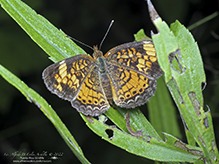 |
|||||
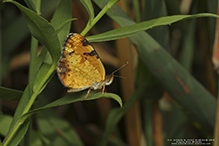 |
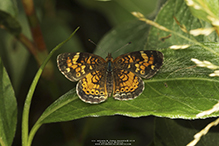 |
||||
Babette Kis |
|||||
Phyciodes tharos pearl crescent |
|||||
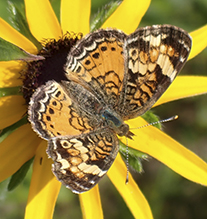 |
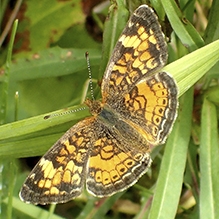 |
||||
Tom Baker |
|||||
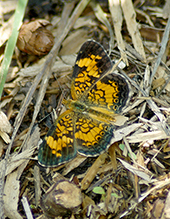 |
|||||
MinnesotaSeasons.com Photos |
|||||
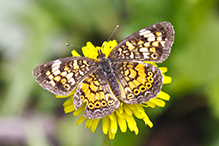 |
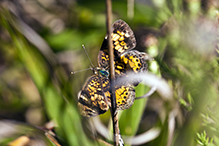 |
||||
 |
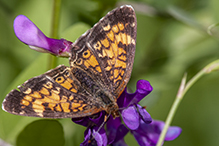 |
||||
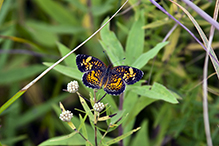 |
|||||
Phyciodes not quite Northern or Pearl This one looks like a pearl crescent above and a northern crescent below. |
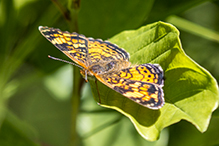 |
||||
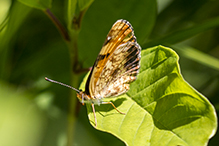 |
|||||


Visitor Videos |
|||
Share your video of this insect. |
|||
| This button not working for you? Simply email us at info@MinnesotaSeasons.com. Attach a video, a YouTube link, or a cloud storage link. |
|||
Other Videos |
|||
| Pearl Crescent (Nymphalidae: Phyciodes tharos) Resting Carl Barrentine |
|||
About
Uploaded on Jul 11, 2009 Photographed at the Rydell NWR, Minnesota (11 July 2009). "He puts Himself--like Leaves-- / And then--He closes up-- / Then stands upon the Bonnet / Of Any Buttercup." --Emily Dickinson |
|||
| Phyciodes tharos - Pearl Crescent Butterfly Resting in a Tree Wise Snake |
|||
About
Published on Sep 9, 2013 Butterfly behaviour video: Ever wonder where many a butterfly go during the night? FACTS: Identification: Quite variable. Males usually have black antennal knobs. Upperside is orange with black borders; postmedian and submarginal areas are crossed by fine black marks. Underside of hindwing has a dark marginal patch containing a light-colored crescent. Spring and fall broods (form marcia) have a gray mottled hindwing below. Wing Span: 1 1/4 - 1 3/4 inches (3.2 - 4.5 cm). Life History: Males patrol open areas for females. Eggs are laid in small batches on underside of host plant leaves. Caterpillars eat leaves and are gregarious when young. Hibernation is by third-stage caterpillars. Flight: Several broods; from April-November in the north, throughout the year in the Deep South and Mexico. Caterpillar Hosts: Several species of smooth-leaved true asters including Aster pilosus, A. texanus, and A. laevis. Adult Food: Nectar from a great variety of flowers including dogbane, swamp milkweed, shepherd's needle, asters, and winter cress. Habitat: Open areas such as pastures, road edges, vacant lots, fields, open pine woods. Range: Southeastern Alberta south through Montana, Wyoming, Colorado, New Mexico, Arizona, and southeastern California to Mexico; east to southern Ontario and all the eastern United States. Conservation: Not usually required. |
|||
| Pearl crescent butterly (Phyciodes tharos) foraging on mist flower, 7/24/12, Maryland metapathogen |
|||
About
Published on Aug 25, 2012 Pearl crescent butterly (Phyciodes tharos) foraging on mist flower (Conoclinium coelestinum), 7/24/12, Maryland |
|||
| Pearl Crescent - August 31, 2013 Don Gagnon |
|||
About
Published on Sep 2, 2013 Pearl Crescent (Phyciodes tharos), Sherborn Power Line, near Fessenden Field, Western Avenue, Sherborn, Massachusetts, Saturday afternoon, August 31, 2013, 12:22 PM / 12:23 PM - Canon EOS REBEL T2i MVI_44416 / MVI_44418; 1:27 min. |
|||
| Pearl Crescent Butterflies mating Pearl Crescent Butterflies mating |
|||
About
Published on Aug 28, 2012 No description available. |
|||


Last Updated:
